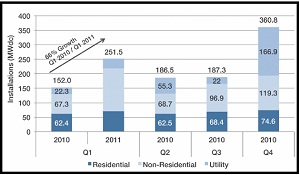2011 U.S. solar installations to double to 1.8 GW, SEIA, GTM Research report
 Today (June 16) the Solar Energy Industries Association (SEIA) and GTM Research said they projected that 1.8 gigawatts of solar will be installed in the U.S. in 2011, doubling the 887 megawatts of solar installed in the U.S in 2010.
Today (June 16) the Solar Energy Industries Association (SEIA) and GTM Research said they projected that 1.8 gigawatts of solar will be installed in the U.S. in 2011, doubling the 887 megawatts of solar installed in the U.S in 2010.
The doubling, together with slower growth in Italy and Germany, are likely to increase the U.S. global market share to 9 percent in 2011—up significantly from the 5 percent to seven percent global share that the U.S. had been trending.
“It's a big reason why the global market is turning its eyes so heavily toward the U.S.,” said GTM Reseach’s Managing Director of Solar Research Shayle Kann.
Kann spoke during a SEIA conference call announcing the release of the “U.S. Solar Market InsightTM: Q1 2011.”
“For those of you that don't follow solar regularly, I would highly recommend that you start paying close attention to the U.S. solar market this year,” Kann said. “Because this is going to be a time that you see enormous changes. A lot of growth, new things going on in terms of project financing, securitization of assets. Everything that comes with the maturation of a sector is going to be compressed into a very short period of time over the next year to year and a half in the U.S.”
On a year-over-year basis, grid connected photovoltaic installations grew 66 percent to 252 installed megawatts in the first quarter of 2011, compared to the first quarter of 2010, said SEIA’s Tom Kimbis, vice president of strategy and external affairs.
“More Americans want solar now,” he said. “As solar prices continue to decline and innovative financing models continue to mature, more Americans are going solar.”
The year-over-year price of solar fell by 15 percent, he said.
“The concentrating solar power [CSP] industry also gained momentum,” Kimbis said. “In total, CSP pipeline has now reached 9 gigawatts in the U.S. There are currently 1.1 gigawatts under construction today in the U.S. That means shovels in the ground and construction workers being put back to work.”
And the results of the first quarter show positive signs for the U.S. market, said Kann.
“The first quarter in the U.S., for seasonal reasons and other reasons, is always slow. So it would be a mistake to look at 252 megawatts installed in the first quarter of this year and assume that that creates a run rate for the year of a gigawatt,” he said. “In fact, a gigawatt this year would be slight growth over 2010, but would certainly be a disappointing year for the industry which is expecting substantially more growth.”
The U.S. market’s growth is accentuated by it diversity, with 50 individual state markets, and growth in the residential, commercial and utility sectors, it’s a more attractive market for investor and manufacturers.
Plus, given steady policy supporting solar over the past few years, it provides more stability than markets in other countries like Germany or Italy, Kimbis said.
Still the U.S. needs to continue to make strategic investments leveraging tax incentives, Kimbis said.
“Smart targeted investments of taxpayer dollars can yield a high return on investment for the public,” Kimbis said. “Most importantly, as we did last year, we need an extension of the 1603 Treasury program throughout the life of the investemnt tax credits.
Policies like the 1603 Treasury program, Kimbis said, provide taxpayers a return on investment and give solar businesses a policy framework that allows them to drive down the cost of solar.
“From this data, we expect the solar industry to again double in 2011. And it puts the solar energy industry within reach of installing our goal of 10 gigawatts of solar annually by 2015,” Kimbis said. “That's enough to power more than 2 million homes in clean reliable solar energy each and every year. But to reach that goal, congress needs to make the right investments in solar energy.”



